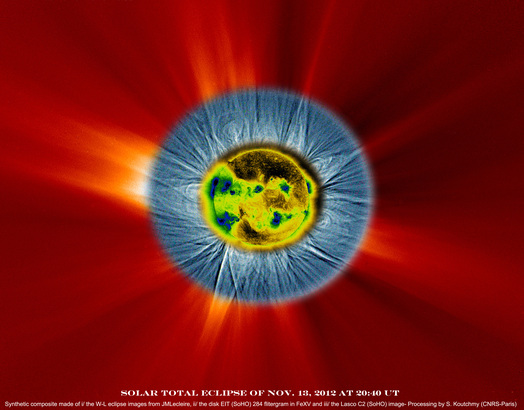Composite Eclipse

Image Credits: J.M. Lecleire & S. Koutchmy, Institut d'Astrophysique de Paris, CNRS/CNES, SOHO (ESA & NASA)
Total solar eclipses offer unique opportunities to study the solar corona, the Sun's outermost atmosphere, in detail from the ground. This composite of the latest eclipse, which was visible from northern Queensland, Australia in the early morning hours of November 14, 2012, shows the magnetic field connection between the solar disk and the coronal structure, including the more outer parts stretched out by the action of the solar wind.
The false-color Sun image in the center was taken by SOHO's EIT instrument in extreme UV light (Fe XV 284 Angstrom). It shows emission produced by very hot plasma in the Sun's inner corona (about 2 million Kelvin).
The bluish, reconstructed eclipse white-light image surrounding the SOHO/EIT image was taken by J.M. Lecleire in Queensland, Australia. It was processed using the Madmax non-linear filter to enhance the fine-scale coronal structures. Here it is seen inserted inside SOHO's reddish LASCO C2 data, in the area where one would normally see the instrument's occulting disk. The C2 image was cleaned in order to remove stars and other objects of no interest in this context.
The composite image displays different types of activity in the corona, even over the normally quiet polar regions, following four medium-size flares recorded the day before the eclipse. The overall coronal structure is very typical for the Sun near sunspot maximum.
Links:
- The Eclipse Megamovie Project


